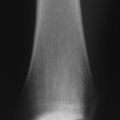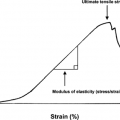Hematologic Malignancies
Valerae O. Lewis
Hematologic malignancies such as lymphoma and myeloma can manifest in bone, and these osseous manifestations can often be the first presentation of the systemic disease. After metastatic disease, myeloma and lymphoma are the second and third major categories in the differential diagnosis of an aggressive bone lesion in an adult. To avoid unnecessary surgery and to create a definitive treatment plan, it is important to become familiar with the presentation and the work-up of these lesions. Often the orthopaedic surgeon is the first to diagnose these diseases; however, surgical intervention may not be required. In addition, because the principles for treatment of hematologic malignancies differ so greatly from sarcomas, the diagnosis must be established before initiation of treatment.
Lymphoma
The vast majority of cases of lymphoma involving bone are non-Hodgkin’s lymphoma (NHL). Non-Hodgkin’s lymphoma is not a single disease, but a group of closely related B- and T-cell cancers of the lymphatic system. B-cell lymphomas represent 85% of NHL cases. Non-Hodgkin’s lymphoma can start in the lymph nodes or lymphatic tissue such as the spleen, stomach, or skin, and because lymphocytes circulate throughout the lymphatic vessels and bloodstream, abnormal lymphocytes can reach any organ. Thus, lymphoma can manifest in any organ. In fact, along with lung carcinoma, lymphoma is one of the most common malignancies that may manifest as soft tissue metastases.
Epidemiology
Incidence of NHL is increasing.
Worldwide incidence has risen steeply from the 1970s to the 2000s.
From a relatively rare disease to the fifth most common cancer in the United States
Purported reasons for rise
Increasing exposure to chemicals
Increasing incidence of viral infections
Increasing incidence of organ transplantation
Increasing number of blood transfusions
Classification
Revised European-American Classification of Lymphoid Neoplasms (REAL) (Table 9-1)
Most common types: diffuse large B-cell lymphoma (45%) and follicular (25%) lymphomas
Clinical classification
Low grade (indolent), intermediate, or aggressive (high grade)
Based on the natural history of the disease
Modified Ann Arbor Staging System (Table 9-2)
Describes extent of disease
International Prognostic Index (IPI: an excellent prognostic tool)
Clinical stage (I/II versus III/IV)
Number of extranodal sites (0 or 1 versus >1)
Lactic dehydrogenase (LDH) (normal versus >1)
Age at diagnosis
Performance status (Eastern Cooperative Oncology Group [ECOG])
The IPI can identify prognostic groups, and for patients with IPI >2 peripheral stem cell or bone marrow transplantation should be considered.
Table 9-1 Real (Revised European-American Classification of Lymphoid Neoplasms) Classification of Non-Hodgkin’s Lymphoma | ||||||||
|---|---|---|---|---|---|---|---|---|
|
Table 9-2 Modified Ann Arbor Staging System | ||||||||||
|---|---|---|---|---|---|---|---|---|---|---|
|
Diagnosis
Clinical Findings
Painless swelling of lymph nodes
Chills
Fever
Night sweats
Malaise
Unexplained weight loss
Staging Studies
Biopsy of lesion/lymph nodes
Computed tomography (CT) scan
Positron emission tomography (PET) scan
Bone marrow biopsy
Treatment
Depends on stage of disease
Multimodality
Combination of chemotherapy and radiation
CHOP with rituximab
CHOP: cyclophosphamide, doxorubicin, vincristine, and prednisone
Rituximab: works by targeting the CD20 antigen on normal and malignant B cells
Peripheral stem cell transplantation
Bone marrow transplantation
Primary Lymphoma of Bone
Primary lymphoma of bone (PLB) is a distinct clinical entity. Although it was first identified by Oberlin in 1928, it was not until 1939, when Parker and Jackson reported on their series of “reticulum cell sarcoma,” that lymphoma of bone was classified distinct from systemic lymphoma.
Definition: malignant lymphoid infiltrate within bone with or without cortical invasion or soft tissue extension but without concurrent involvement of regional lymph nodes or distant viscera
Synonyms
Reticulum cell sarcoma (misnomer; not a sarcoma)
Malignant lymphoma of bone
Primary skeletal lymphoma
Osteolymphoma
Epidemiology
Diagnosis
Clinical Findings
Localized bone pain
Mass
Pathologic fracture in 20% to 30%
Generally not systemically ill







